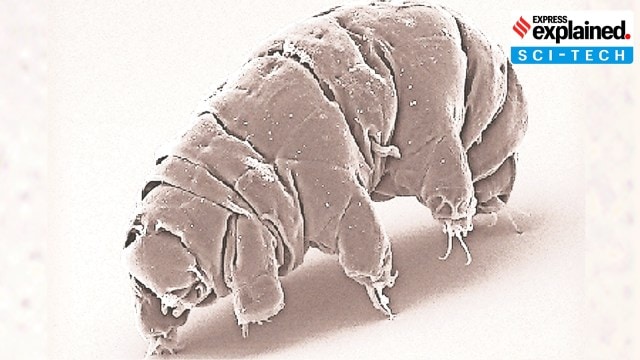How a tardigrade resists high levels of radiation, implications for humans
The findings could one day be harnessed to help protect astronauts from radiation during space missions, clean up nuclear pollution or improve cancer treatment, according to a report in Nature.
 Tardigrades have long fascinated scientists as they can withstand extreme conditions.
Wikimedia Commons (File Photo)
Tardigrades have long fascinated scientists as they can withstand extreme conditions.
Wikimedia Commons (File Photo)A team of researchers has identified the genetic mechanisms that help a newly discovered species of tardigrades (Hypsibius henanensis) withstand high levels of radiation. The species comprises thousands of genes, which become more active when exposed to radiation. They protect the microscopic animals’ DNA from damage and repair breaks, according to the scientists.
Their study, ‘Multi-omics landscape and molecular basis of radiation tolerance in a tardigrade’, was published in the journal Science last week. The scientists involved in the research are affiliated with several institutions in China.
The findings could one day be harnessed to help protect astronauts from radiation during space missions, clean up nuclear pollution or improve cancer treatment, according to a report in Nature.
Lingqiang Zhang, a biologist at the Beijing Institute of Lifeomics and co-author of the study, told Nature, “This discovery may help improve the stress tolerance of human cells, benefiting patients undergoing radiation therapy.”
How was the study carried out?
Zhang and his colleagues discovered a new species of tardigrade six years ago after they brought back moss samples from Funiu Mountain in China’s Henan province to their laboratory.
They named it Hypsibius henanensis and began to analyse its characteristics. Also known as water bears or moss piglets, tardigrades have long fascinated scientists as they can withstand extreme conditions.
The team of scientists sequenced the genome of this new species and revealed that it had 14,701 genes, 30% of which were unique to tardigrades. They then exposed Hypsibius henanensis to radiation doses of gamma rays that were far beyond what would be survivable for humans, the Nature report said.
What did the study find?
The scientists discovered 2,801 of the genes in Hypsibius henanensis that were involved in DNA repair. More specifically, they found three factors that help this species survive radiation.
The first was its ability to quickly repair double-strand breaks in DNA due to radiation exposure, by using a protein called TRID1. “The second factor involved a gene that was switched on during exposure to radiation, resulting in the generation of two proteins that are known to be important for mitochondrial synthesis… in tardigrades, it appears they also help with DNA repair,” according to a report by phys.org.
The third one was Hypsibius henanensis’s ability to produce different types of antioxidant pigments called betalains. These pigments can mop up some of the harmful reactive chemicals that radiation causes to form inside cells, the Nature report said.
Notably, the researchers tested one of the tardigrade’s betalains on human cells and found it significantly improved their survival rate after radiation exposure.



- 01
- 02
- 03
- 04
- 05



































